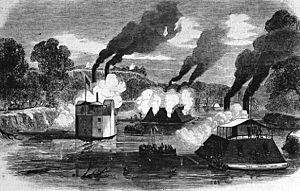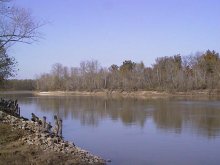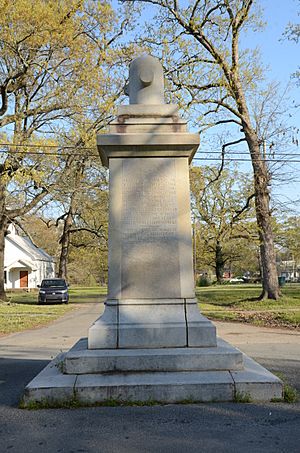Battle of St. Charles facts for kids
Quick facts for kids Battle of St. Charles |
|||||||
|---|---|---|---|---|---|---|---|
| Part of the Trans-Mississippi Theater of the American Civil War | |||||||
 The Battle at St. Charles, White River, Arkansas—Explosion of the "Mound City" by Alexander Simplot |
|||||||
|
|||||||
| Belligerents | |||||||
| Commanders and leaders | |||||||
|
|||||||
| Strength | |||||||
|
|
||||||
The Battle of St. Charles happened on June 17, 1862, in St. Charles, Arkansas. It was part of the American Civil War. Earlier that year, a Union Army led by Major General Samuel R. Curtis was trying to reach Little Rock, Arkansas. However, his army got stuck near Batesville because they ran out of supplies.
To help Curtis's army, the Union leaders decided to send ships up the White River. These ships would bring much-needed supplies. The Confederate commander in Arkansas, Major General Thomas C. Hindman, knew about this plan. He quickly built defenses near St. Charles to stop the Union ships.
The Confederates set up two artillery positions (places with cannons). They also sank three of their own ships, including the CSS Maurepas, in the river. This was to block the Union ships from passing.
On June 17, Union ships moved towards the Confederate defenses. The 46th Indiana Infantry Regiment went ashore to attack the land defenses. Meanwhile, two ironclad ships and two timberclad ships attacked from the river. During the fight, a Confederate cannonball hit the Union ironclad USS Mound City. It broke one of the ship's steam drums.
Hot, scalding steam filled the Mound City. This terrible event killed or wounded almost everyone on board. Only about 25 of the 175 men survived without harm. This shot is known as one of the deadliest single shots of the entire war.
Despite this, the 46th Indiana soldiers took over the Confederate defenses on land. The Union won the battle. However, the supply mission could not reach Curtis's army because the river water levels became too low. Curtis's army then marched to Helena, Arkansas. Today, part of the battlefield is a historic site called the St. Charles Battle Site.
Contents
Why the Battle of St. Charles Happened
Arkansas Joins the Confederacy
After Abraham Lincoln became President in 1860, many southern states thought about leaving the United States. Arkansas held a meeting in February 1861 to decide if they should secede. At first, most people at the meeting did not want to leave the Union.
But then, Confederate soldiers attacked Fort Sumter in April 1861. This made many people in Arkansas change their minds. On May 6, Arkansas voted to leave the Union. It then joined the Confederate States of America.
Union Army Moves into Arkansas
In early 1862, a big Confederate army, the Army of the West, was formed. It was led by Major General Earl Van Dorn. This army fought against the Union army of Major General Samuel R. Curtis at the Battle of Pea Ridge. The Confederates lost this battle.
After the defeat, Van Dorn moved his army out of Arkansas. This left Arkansas with very few soldiers and supplies. Curtis's Union army then moved into Arkansas. They reached Batesville by May 2.
Curtis wanted to capture the state capital, Little Rock. His soldiers crossed the White River. But by May 19, his supply lines were stretched too thin. He realized he could not keep going without more supplies.
Union Plans to Resupply Curtis
Curtis sent a message asking for help. The Union leaders decided to send a group of ships up the White River. This naval force would bring supplies to Curtis's army.
Flag Officer Charles Henry Davis was put in charge of this mission. He gathered several ships, including ironclads and timberclads. He also asked Colonel Graham N. Fitch and his 46th Indiana Infantry Regiment to join. These nearly 1,000 soldiers would protect the ships from attacks on land.
Confederate Defenses at St. Charles
Confederate Major General Thomas C. Hindman was now in charge in Arkansas. He worked hard to rebuild the Confederate forces. He expected the Union to try to use the rivers for supplies.
Hindman chose a spot near St. Charles on the White River for defenses. It was a good place because of the bluffs (steep hills) overlooking a bend in the river. Captain A. M. Williams and 100 soldiers were sent to build these defenses.
They put logs into the river bottom to block Union ships. They also built two cannon batteries on the bluffs. Two powerful 32-pounder cannons were placed in the main battery. Two smaller 3-inch cannons were in another position nearby.
The Confederate gunboat CSS Maurepas arrived on June 14. On June 16, Hindman learned that Union ships were coming. He ordered two civilian steamboats to be sunk to further block the river. Captain Joseph Fry, commander of Maurepas, also sank his ship. But first, they removed some cannons from it.
In total, the Confederates had seven cannons and 114 men defending St. Charles. Many of their sailors had only single-shot pistols, which were not very useful in a land battle.
The Battle Begins

On the morning of June 17, the Confederates got ready for the attack. Captain John W. Dunnington and his sailors were in the upper battery with the big 32-pounder cannons. Other Confederate sailors were in the lower battery with three cannons. Infantry soldiers were sent downstream to act as sharpshooters.
Around 6:00 AM, the Union ships began moving upriver. The ironclad Mound City led the way, followed by St. Louis, Lexington, and Conestoga. The unarmed supply ships stayed behind.
When the ships were about 2.5 miles from St. Charles, they saw Confederates on the river bank. Mound City fired, scattering them. Then, the Indiana infantry soldiers got off their transport ships. They formed a skirmish line and began moving towards the Confederate defenses on land.
The Union plan was for the soldiers on land and the ships on the river to attack at the same time.
The Deadly Shot
Mound City continued to move forward. The lower Confederate battery opened fire, but their shots missed. The Union commander, Commander Augustus Kilty, was not sure exactly where all the Confederate cannons were. He kept the timberclads back while the ironclads moved closer.
For about 15 minutes, Mound City and St. Louis fought with the lower battery. Then, Mound City moved even closer to Dunnington's upper battery. The Confederates there opened fire.
At 10:03 AM, a Confederate cannonball hit Mound City. It struck the ship's side near a gun opening and went through the armor. Three or four sailors were killed instantly. The cannonball then hit one of the ship's steam drums. These drums held hot, high-pressure steam for the ship's engines.
Steam burst out, filling the ship and badly scalding many men. Many who could not escape quickly died. Out of about 175 men on Mound City, 105 to 125 were killed, and 25 to 44 were wounded. Only about 25 men escaped unharmed. This single shot caused a huge loss of life.
Union Victory
With steam pouring out, Mound City drifted downstream and hit the riverbank. Captain Fry of the Confederates demanded that the Union sailors surrender. When they refused, he ordered his men to fire on Union sailors trying to swim away. Several wounded men were killed.
With Mound City out of the fight, St. Louis continued to battle Dunnington's cannons. But then, Colonel Fitch signaled for the ships to stop firing. His infantry soldiers were about to attack the Confederate positions. He wanted to avoid accidentally hitting his own men.
Fitch's soldiers climbed the bluffs. They moved to a position where they could attack the Confederate defenses from the side. Captain Williams tried to use a nearby house for defense, but the Union soldiers got there first.
After hearing this, Captain Fry ordered his men to disable their cannons and leave the lower battery. They did this by driving a metal spike into the cannon's firing hole. After a short fight, it was clear the Confederates would be captured if they did not retreat.
Fry ordered Dunnington to cover the retreat. But Dunnington refused, saying his men had no weapons or had already used their single-shot pistols. After one last shot at St. Louis, the Confederates scattered. Union troops were very close behind them.
During the retreat, Captain Fry was wounded and captured. In total, 29 Confederates were captured. After taking the defenses, Fitch signaled the Union ships. Lexington and St. Louis moved up to where the sunken ships blocked the river. Conestoga towed the damaged Mound City downstream.
Union soldiers patrolled St. Charles. The town's people were warned that the town would be destroyed if there was any guerrilla fighting. Because the Confederates fired on Mound City's wounded, 20 Confederate prisoners, including Fry, were arrested. The battle lasted less than four hours.
After the Battle
Commander Kilty was badly scalded on Mound City and lost an arm. Lieutenant Wilson McGunnegle took command of the Union expedition. A new crew of 58 or 59 men from the 46th Indiana Regiment was put on Mound City.
About 58 or 59 Union soldiers who died were buried in a mass grave. Eight Confederate soldiers were buried in St. Charles. Historians estimate that the Union had about 160 casualties (killed or wounded). The Confederates lost about 40 men. The 46th Indiana Regiment had very few casualties.
One historian, Mark Hubbs, said that the single shot that hit Mound City caused seven percent of all Union Navy battle deaths in the entire war. The Union wounded were sent back to Memphis. The Union troops captured six Confederate cannons. They destroyed the Confederate defenses after the battle.
The Union fleet, now led by McGunnegle, continued up the White River. Mound City was left behind for repairs but later returned to service. The ships reached Clarendon, Arkansas, but had to stop because the water levels were too low. Fitch's soldiers went ashore and fought with Confederate cavalry, losing 55 men.
The Union ships decided to turn back on June 20 because the river was too shallow. They returned to the mouth of the river by June 25. Major General Ulysses S. Grant then took command of Union forces in Memphis. He sent more supply ships and soldiers to join the White River fleet.
The ships tried again to go upriver, but the water levels kept falling. They could not reach Curtis's army. Curtis learned this and decided to march his army without supplies. This was a very risky move. His army marched for two weeks, freeing enslaved people along the way.
The Confederates tried to stop Curtis's march once. On July 7, they attacked his force at the Cache River. But the Union soldiers fought them off. Curtis's army finally reached Helena, Arkansas, on July 12. Helena later became an important base for the Union Army.
Battlefield Today
Part of the battlefield is now a protected site called the St. Charles Battle Site. It is listed on the National Register of Historic Places. In the 1930s, divers found two cannons from the battle in the river.
There is also a monument called the St. Charles Battle Monument. It was placed in 1919. This monument is special because it honors both the Union and Confederate soldiers who fought there.
Images for kids
-
Map of the Battle of St. Charles, 1862, and surrounding area. The red circle within the yellow zone surrounds the primary area of the battlefield, the purple section represents the area listed on the National Register of Historic Places (NRHP), and the yellow area is that which is potentially NRHP-eligible.









